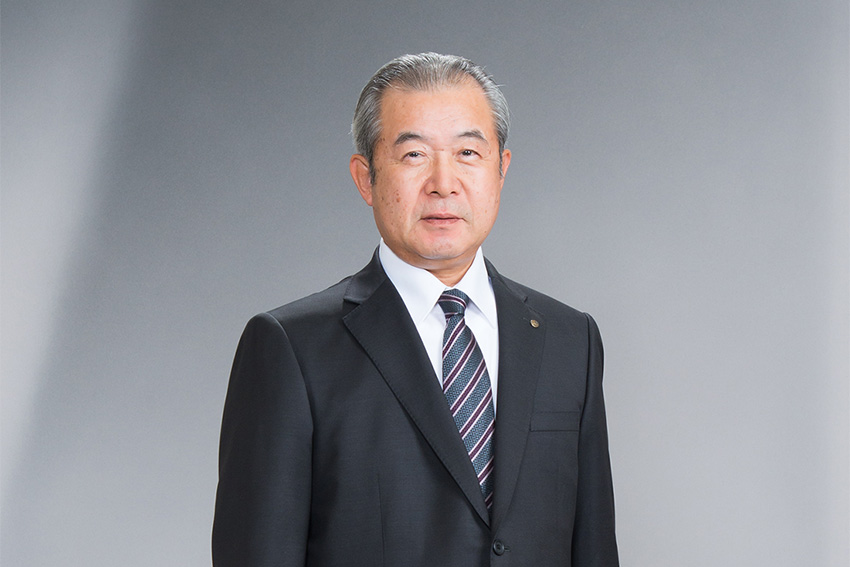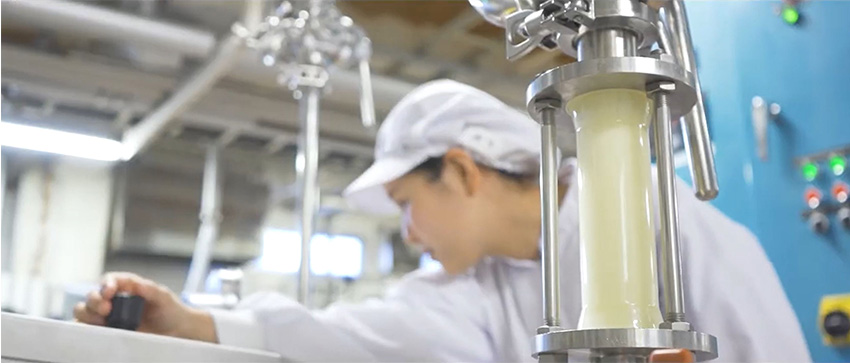Tsukishima Foods Industry is taking processed oils and fats, chocolates, frozen dough, and frozen cakes to the next level in a sustainable way that customers appreciate and enjoy.

Over the past decade, Japanese food exports have reached new heights and are projected to reach 1.45 trillion yen in 2023. This trend is also reflected in international markets, where the number of Japanese restaurants is expected to grow by 20% from 2021, with approximately 200,000 Japanese restaurants expected to open worldwide in 2024. How can we explain the growing popularity of Japanese food and the record increase in export values?
This is my personal opinion, but I believe that the skills and technology of Japanese food companies are among the best in the world when it comes to the food business. Not only that, but Japanese companies have a mindset of responding to customer needs. For that reason, I think there will be more and more opportunities for Japanese food to be recognized by people around the world in the future.
Some of our clients have asked us to help them export products such as frozen cakes and other confectionery items, and we are seeing this growing every year. Other clients want us to produce food ingredients such as processed oils and fats, creams and custards for export, all of which comply with international trade standards and are safe to eat. We have developed several products and continue to actively develop others.
The government saw these numbers and set out to boost them even further. The goal is to make food exports worth 5 trillion yen in 10 years' time, with a focus on expanding the marketing of Japanese food around the world. How can Japan achieve these lofty goals for food exports set by the Japanese government?
Given the growth rate so far, it may be difficult, but I wouldn't say it's impossible. The weak JPY is attracting more inbound tourists to Japan, and social media like YouTube is making it easier to spread information about Japan and Japanese food.
I understand that the Ministry of Agriculture, Forestry and Fisheries is working hard to promote the export of Japanese products. One way to accelerate exports is to further promote Japan as a tourist destination and encourage people to enjoy Japanese food and cuisine. Tourists visiting Japan are often surprised at the difference in taste compared to their home countries, and although there are many Japanese restaurants overseas, the quality of the food is different. I think that if people from many countries could try traditional Japanese cuisine such as sushi and tempura, as well as processed frozen foods and sweets, it would accelerate the acceptance of Japanese food overseas.
Most of our products are ingredients for cakes and sweets, but we believe that Japanese products are delicious for people in any country. Increasing exports and getting Japanese food accepted is now an important issue, but in order to do so, we need to focus on developing products that suit the tastes of the destination country. We always work together with our customers to meet their needs and develop products from the customer's perspective. For overseas customers, we also try to create products that suit the local tastes.
Tofu and soy, staples of the Japanese diet, have only recently become popular in the West as meat-free alternatives. The plant-based food market in Japan is growing 23% year-on-year and is predicted to exceed 2 trillion yen by 2030. Your company has entered this field with the "POFF" series, which stands for plant-based oils and foods. POFF offers 19 types of plant-based ingredients that replicate the taste of meat using meat substitutes. How important is the POFF brand to your business going forward and what role do you think plant-based foods will play in the future?
Such vegetarian products will not grow at an accelerated pace in Japan. This is due to the religious views of the Japanese people themselves, and I think that plant-based products have the potential to grow overseas. Tsukishima Foods has little experience in direct export overseas, so we sometimes ask trading companies to do the work. We are focusing on introducing sweets made with our ingredients to overseas markets because we are confident that people overseas will be pleased with them. If you are interested in our products, we can export them or provide our technology to overseas companies. Of course, this approach involves a lot of risks, so another option is to help local companies produce overseas. Interest in vegetarian products is higher overseas than in Japan.
Are there any countries where you get a lot of inquiries?
We receive inquiries from all over the world. There is no country in particular that we receive more inquiries from. Tsukishima Foods is also a total solutions company that meets with clients face-to-face to discuss their business. Then, based on that information, we try to implement solutions that solve the challenges our clients are facing. What is your competitive advantage as a total solutions company?
Although we are a small company, we are expanding our market share in the processed food and oils and fats sectors, which are unfortunately shrinking due to the aging population and the impact of COVID-19. As you say, we provide total solutions to our customers and consult on the issues they are currently facing. We position ourselves as a problem-solving partner, and this aspect of our business has earned us the trust of our customers.
This is a process we have been conducting for many years. That is why, if we have the opportunity to develop this kind of business overseas, we are prepared to take the same approach to serving customers in overseas markets. Tsukishima Foods is like a partner that accompanies our customers on their problem-solving journey.
R&D is a specialty of Japanese companies, and on average Japanese companies spend around 3% of their annual Gross Domestic Product (GDP) on R&D. This is significantly more than other developed countries such as China, which spend just over 1% of their GDP. Your company has a unique "Tsukishima-style" R&D process that brings together different departments to collaborate and share ideas. This has led to unique developments such as the fermentation process. Could you tell us about the benefits of this process and how it allows different departments to come together to exchange information?
It's unusual for a Japanese company, but we're not listed on the stock exchange, but 400 of our 600 employees own shares in our company, meaning that about 50% of the stock is owned by employees. This means that our employees have a sense of management while working here. Sometimes we have different opinions, but if there's a problem, we work together to get things back on track. This is the same attitude we have when dealing with customers.
The headquarters building also houses our customer service department, research and development department, and production building. For a company of this size, with such diverse offices, we all work together in the same direction. Having everything in place also allows the company to respond quickly to requests.

Basic Research Station
Are you currently exploring new partnerships overseas, and if so, which markets do you see as key for future growth?
We are considering our options. Currently, we have partners in Indonesia, Taiwan, and China, but it's not easy. If we were to find a partner, it would be somewhere else. Our basic policy is always to work with our customers, so if they have a specific region in mind, we will consider that too. After all, we follow the founder's message: a company always belongs to its employees.
You mentioned that you are also looking beyond Indonesia, Taiwan, and China. Are there any other countries besides these three that you think have future growth potential or that you are interested in?
As for overseas expansion, we are not actively considering it as we do not have much experience at the moment. However, we do receive inquiries from overseas, and in those cases, we are considering the possibility of taking products developed for Japan overseas.
Currently, Japan's declining population means there are fewer people to sell products to and the Japanese market is shrinking. This has forced some companies to look overseas to find new opportunities. What challenges and opportunities do you think this demographic change is creating for your company?
In terms of production volume, we currently have a market share of approximately 12%, and as the market shrinks, we intend to expand our market share while maintaining our current production volume.
Due to the shrinking oil and fat market, there is a possibility that other companies in the industry will withdraw from the market. However, we believe that we are a company that always competes on quality and service, not on price. By sticking to this attitude, we have been able to build good relationships with our customers, and in order to continue our business, we need to value our customers and prosper together with them. This way of thinking will ultimately lead to an increase in market share. As our market share expands, we will also need to increase our production capacity, so we aim for gradual growth rather than rapid growth.
Imagine you are doing this interview again in four years. What goals or dreams do you want to achieve by the time of this new interview?
We have reviewed our business plan and set some goals for the next three years. We hope to expand our market share and leverage our strengths by the time of our next interview. I can't give you an exact figure today because business is not just about numbers, it's about customers and keeping them by exceeding their expectations. Our employees are doing their best to support our customers.
For more information, visit their website at: https://www.tsukishima.co.jp/en/
0 COMMENTS